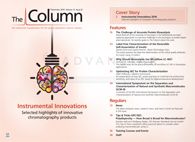Optimizing SEC for Protein Characterization
The ability of size-exclusion chromatography (SEC) to measure critical protein characteristics, such as molecular weight and size, makes the technique valuable from the early stages of novel protein research and development through to formulation and manufacturing support, especially in oligomeric purity and aggregation studies. However, informational output, ease of analysis, and sample requirements all vary considerably depending on whether a system has been truly optimized for protein characterization. This article examines how SEC works and considers how to maximize the productivity, sensitivity, and value of an SEC setup for biopharmaceutical development.
Photo Credit: Aepsilon/Shutterstock.com

Mark Pothecary, Malvern Instruments, Houston, Texas, USA
The ability of size-exclusion chromatography (SEC) to measure critical protein characteristics, such as molecular weight and size, makes the technique valuable from the early stages of novel protein research and development through to formulation and manufacturing support, especially in oligomeric purity and aggregation studies. However, informational output, ease of analysis, and sample requirements all vary considerably depending on whether a system has been truly optimized for protein characterization. This article examines how SEC works and considers how to maximize the productivity, sensitivity, and value of an SEC setup for biopharmaceutical development.
As a routine technique within the biopharmaceutical industry, size-exclusion chromatography (SEC) is most commonly used to study product purity and protein aggregation, an issue of concern that negatively impacts efficacy and is thought to increase the risk of an immunogenic response (1,2). Beyond this, it is increasingly applied to gain insight into the state of oligomerization of a drug to identify which form a protein is in when most active, to characterize the composition of polyethylene glycol (PEG)-ylated and membrane proteins, and to support biocomparability studies.
These applications mean that SEC is used in research and development and early formulation studies when sample availability is limited in terms of volume, and it is critical to extract as much information as possible from every microlitre. At this stage, sensitivity is crucial because higher sensitivity translates directly into a smaller sample volume requirement as well as the production of more robust data. Furthermore, with high numbers of samples, analytical productivity is a concern.
As a drug progresses through development, its properties are characterized in increasing levels of detail and, though sensitivity and productivity remain important, accessing and combining all relevant information becomes the defining goal. Issues such as higher order structure become progressively more important - to optimize stability, for example, or to demonstrate equivalence in a biosimilar.
Optimizing the value of SEC across biopharmaceutical development therefore relies on understanding and controlling the issues and factors that affect sensitivity, ease-of-use, and information flow. Understanding how the technique works provides a logical starting point.
Understanding SEC
A defining feature of SEC is that it is a twoâstep technique. First, samples are separated into fractions on the basis of protein hydrodynamic size, then the fractions are characterized using one or more detectors. Separation is achieved by passing the sample through a chromatography column packed with an inert porous gel media. Detection enables determination of the size distribution and, more importantly, the molecular weight of each of the different populations within the sample.
Certain characteristics of SEC, and the way that it is configured within the laboratory, are a direct result of its two-step nature. For example, users can choose to buy a complete integrated system or adopt a “pick and mix” approach, adding a sophisticated detector array or individual detectors from different suppliers to an existing SEC high performance liquid chromatography (HPLC) separation unit. Indeed, it’s not uncommon to be able to read the age of an SEC system from the associated proliferation of add-ons that reflect advances in technology since the original unit was purchased!
When it comes to optimization, clearly both steps of the analytical process need to be considered. Investing in a high performance separation module alone is insufficient but, equally importantly, the information flow from a powerful detector array will be compromised by a poor separation.
A Clean Separation
Measuring accurate and detailed information for each population within a sample relies, in the first instance, on a precisely resolved separation. This provides a stable baseline for subsequent analysis, boosting the signalâtoânoise ratio achieved during detection. Better separation performance sets the foundation for enhanced accuracy and higher sensitivity.
Performance in this part of the system depends substantially on the characteristics of each component of the separation module, with certain features of the degasser, autosampler, and separation column particularly helpful for efficient protein analysis.
- Degasser: Effective degassing of the sample is essential to secure a stable measurement baseline. The speed and efficiency of the degasser unit directly impacts productivity, with low-volume units offering the added advantage of a quicker switchover when, for example, measuring in different buffers.
- Autosampler: An autosampler boosts instrument productivity and can aid the integration of SEC into the analytical workflow, particularly if it permits injection from a favoured sample format such as a vial or microtiter plate. Maintaining the integrity of the sample is crucial, so temperature control down to around 4 °C is particularly beneficial for proteins. Modern autosampler designs also offer zero overhead injection, meaning that all of the sample injected is analyzed, with no waste. This can be an important advantage when sample is scarce.
- Separation Column: Silica columns are well-suited to protein SEC, with the best commercially available options delivering excellent compatibility with a diverse range of proteins, including hydrophobic samples, such as PEGylated proteins. Columns that are specified to minimize column particulate shedding provide a cleaner baseline for light scattering detection, and high separation efficiency makes it possible to achieve excellent resolution using just one column, as opposed to two in series - a valuable gain.
Comprehensive Detection
Although the seeds of sensitivity are sown in the separation module, it is detector choice that defines information flow, with every detector included contributing to the data acquired. Light scattering detectors are particularly helpful for protein analysis because they enable the measurement of absolute molecular weight without the need for column calibration using a series of molecular weight standards. Molecular weight is a defining parameter for proteins and biomolecules, and for many such species there are no relevant standards available, so this benefit is considerable. Furthermore, a light scattering detector can be used to detect problem interactions between the sample and the column surface that are compromising separation performance, aiding troubleshooting.
Three different types of static light scattering detector are available. These are classified on the basis of the angle at which they detect scattered light, and their relative merits should be considered carefully when it comes to choosing between them. For a more detailed discussion of light scattering, to understand how the detectors work, their advantages and limitations, and how measured results are converted to molecular weight data, please refer to reference (3). In summary, the options include:
- Right-Angle Light Scattering (RALS): The simplest type of light scattering detector available and the most accurate choice for molecules less than 15 nm in radius, including most proteins and oligomers. RALS detectors have high signal-to-noise ratio and are therefore extremely sensitive.
- Multi-Angle Light Scattering (MALS): The established industry standard for biopharmaceuticals. However, because most proteins are under 10 nm in size, and consequently scatter light isotropically (with equal intensity at all angles), the ability to detect at multiple angles adds little value. For larger aggregates, MALS can provide additional information in the form of radius of gyration (Rg) measurements.
- Low-Angle Light Scattering (LALS): The most accurate choice for larger molecules and aggregates, which avoids the extrapolation inherent in MALS detector use.
Whichever light scattering technology is selected, sensitivity is a defining parameter in terms of its capabilities for protein characterization. Higher sensitivity means more accurate data, using less sample, and at lower concentrations. It also extends the applicability of SEC to lower molecular weight materials. All of these benefits magnify the value of SEC in drug development.
To determine the quantity of material present in any eluting fraction requires concentration detection. There is a choice of two established technologies here, though adopting both in combination can be advantageous.
Ultraviolet (UV) and Refractive Index (RI): Many biopharmaceutical researchers rely on a UV detector for concentration measurement, but quantification requires the protein’s extinction coefficient to be known. An RI detector, in contrast, measures protein concentration based on the largely constant dn/dc value, reducing the need for a priori information. In combination, UV and RI detectors can be used to quantify the composition, for example, of protein conjugates.
Beyond these key components, there are two additional detectors that should be considered when assembling an optimized SEC detector array for protein studies.
Viscometer: Intrinsic viscosity determination is an optional addition to a light scattering system. It offers information on structural aspects, such as broad conformational changes, or folding and denaturing. In addition, if combined with a light scattering detector, it can be used to measure the hydrodynamic radius (Rh) down to less than 1 nm, comfortably spanning the size range of interest for proteins.
Dynamic Light Scattering (DLS) Detector: DLS is an established technique for Rh measurement within the industry, so adding a DLS detector into the array can be a more familiar alternative to a viscometer for size measurement. DLS extends size measurement down into the sub-10-nm range, thereby complementing the sizing capabilities of static light scattering but, unlike a viscometer, is not able to provide more detailed structural insight.
Eliminating Inefficiencies
The inclusion of multiple detectors improves the accuracy and analytical productivity of SEC. However, retaining resolution throughout the detector array is essential for maintaining data quality as the amount of data gathered increases. Opting for an integrated system can offer significant benefits in this area. Such units can include detectors and tubing in a single-temperature controlled environment to improve baseline stability. They also minimize the length of inter-detector tubing, which can contribute additional unwanted bandâbroadening (4).
An Evolving Technique
Fully-integrated systems with triple- or tetraâdetector arrays bring value to many stages of biopharmaceutical development, formulation, and manufacturing, using ever smaller amounts of sample. Such systems enable highly sensitive aggregate detection, even when sample availability is scarce.
However, the informational output of SEC means that it retains value throughout the development pipeline, for the increasingly detailed investigation of protein aggregation and stability via the determination of absolute molecular weight, hydrodynamic size, polydispersity, structure, and composition. Such information supports the development of safe and effective drugs, biocomparability studies, and the associated development of biosimilars. Optimizing each element of an SEC system makes it possible to access all this information efficiently.
References
- http://en.wikipedia.org/wiki/Immunogenicity
- US Food and Drug Administration, Guidance For Industry: Immunogenicity Assessment For Therapeutic Protein Products, (FDA, Rockville, Maryland, USA, 2014).
- “Static light scattering technologies for GPC – SEC explained.” Malvern Instruments whitepaper available for download at: http://www.malvern.com/slsexplained.
- http://www.waters.com/waters/en_US/Chromatographic-Bands,-Peaks-and-Band-Spreading/nav.htm?cid=134803614&locale=en_US
Mark Pothecary studied biochemistry for his undergraduate degree in Bath, UK, before moving to London to complete his Masters and Ph.D., also in biochemistry. His PhD project focused on the investigation of the cardiovascular benefits of wine polyphenols. Mark joined Malvern in 2008 as a product technical specialist, concentrating on SEC applications in biosciences. Having moved to Houston, Texas, USA, in 2012, he is now the Americas Product Manager for Malvern’s GPC/SEC products.
E-mail:mark.pothecary@malvern.com
Website:www.malvern.com

New Method Explored for the Detection of CECs in Crops Irrigated with Contaminated Water
April 30th 2025This new study presents a validated QuEChERS–LC-MS/MS method for detecting eight persistent, mobile, and toxic substances in escarole, tomatoes, and tomato leaves irrigated with contaminated water.

.png&w=3840&q=75)

.png&w=3840&q=75)



.png&w=3840&q=75)



.png&w=3840&q=75)












